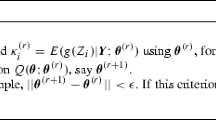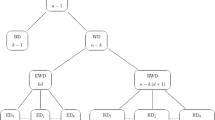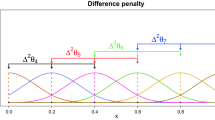Summary
This paper presents a flexible model for the mean and variance of a dependent variable. The variance is modelled as a product of a dispersion parameter and a known variance function of the mean. The dependence of each of the mean and dispersion parameter on explanatory variables is modelled using a semi-parametric additive model. We call this model the ’Mean and Dispersion Additive Model’ or ’MADAM’. The MADAM is fitted either by maximisation of the penalised extended Quasi-likelihood or by pseudo-maximization of the penalised Normal likelihood. A successive relaxation fitting algorithm is described and is implemented in GLIM4 allowing flexible and interactive modelling of both the mean and dispersion of a dependent variable. Two examples are given to demonstrate the use of the MADAM for modelling overdispersion in each of Poisson regression model and a Binomial logistic regression model.
Access this chapter
Tax calculation will be finalised at checkout
Purchases are for personal use only
Preview
Unable to display preview. Download preview PDF.
Similar content being viewed by others
References
Aitkin, M. (1987) Modelling variance heterogeneity in normal regression using GLIM. Appl. Statist., 36, 332–339.
Carroll, R.J. and Ruppert, D. (1988) Transformations and Weighting in Regression. London: Chapman and Hall.
Davidian, M. and Carroll, R.J. (1987) Variance function estimation. J. Am. Statist. Ass., 82, 1079–1091.
Davidian, M. and Carroll, R.J. (1988) A note on extended quasi- likelihood. J. R. Statist. Soc. B, 50, 74–82.
de Boor, C. (1978) A Practical Guide to Splines. New York: Springer.
Efron, B. (1986) Double Exponential Families and their use in Generalised Linear Regression. J. Am. Statist. Ass., 81, 709–721.
Green P.J. and Silverman B.W. (1994) Nonparametric Regression and Generalised Linear Models. London: Chapman and Hall.
Harvey, A.C. (1976) Estimating regression models with multiplicative heteroscedasticity. Econometrica, 41, 461–465.
Hastie, T.J. and Tibshirani, R.J. (1990) Generalized Additive Models. London: Chapman and Hall.
McCullagh, P. and Neider, J.A. (1989) Generalised Linear Models (2nd ed.), London, Chapman and Hall.
Muller, H. G. and Stadtmuller, U. (1987) Estimation of heteroscedasticity in regression analysis. Ann. Statist., 15, 610–625.
Neider, J.A. (1992) Joint modelling of the mean and dispersion. In Statistical Modelling, 263–272 (P.G.M. Van der Heijden, W. Jansen, B. Francis and G.U.H. Seeber eds). North Holland: Amsterdam.
Neider, J.A. and Pregibon, D. (1987) An extended quasi- likelihood function. Biometrika, 74, 211–232.
Neider, J.A. and Lee, Y. (1992) Likelihood, Quasi-likelihood and Pseudo likelihood: Some Comparisons. J. R. Statist. Soc. B, 54, 273–284.
Pregibon, D. (1984) Review of Generalised Linear Models.Ann. Statist., 12, 1589–96.
Rigby, R.A. and Stasinopoulos, D.M. (1994) Robust fitting of an Additive model for variance heterogeneity. In COMPSTAT, Proceedings in Computational Statistics, eds R. Dutter and W. Grossmann, pp 261–268, Physica-Verlag.
Rigby, R.A. and Stasinopoulos, D.M. (1995) A semi-parametric Additive model for variance heterogeneity, (to appear in Statistics and Computing).
Silverman, B.W. (1985) Some aspects of the spline smoothing approach to non-parametric regression curve fitting (with discussion). J. R. Statist. Soc. B, 47, 1–52.
Stasinopoulos, D. M. and Francis, B. (1993) Generalised Additive Models in GLIM4.GLIM Newsletter, 22, 30–36.
Stasinopoulos, D. M. and Rigby, R. A. (1992) Detecting break points in generalised linear models. Computational Statistics and Data Analysis, 13, 461–471.
Verbyla, A.P. (1993) Modelling variance heterogeneity: residual maximum likelihood and diagnostics. J. R. Statist. Soc. B 55, 493–508.
Author information
Authors and Affiliations
Editor information
Editors and Affiliations
Rights and permissions
Copyright information
© 1996 Physica-Verlag Heidelberg
About this paper
Cite this paper
Rigby, R.A., Stasinopoulos, M.D. (1996). Mean and Dispersion Additive Models. In: Härdle, W., Schimek, M.G. (eds) Statistical Theory and Computational Aspects of Smoothing. Contributions to Statistics. Physica-Verlag HD. https://doi.org/10.1007/978-3-642-48425-4_16
Download citation
DOI: https://doi.org/10.1007/978-3-642-48425-4_16
Publisher Name: Physica-Verlag HD
Print ISBN: 978-3-7908-0930-5
Online ISBN: 978-3-642-48425-4
eBook Packages: Springer Book Archive




